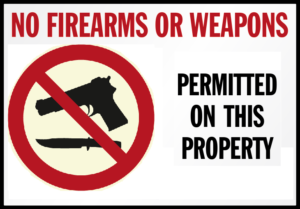
It is LEGAL to carry a firearm onto any private property or businesses with “No Weapon” and “No Firearm” signs.
Utah law 76-8-311.1 (1)(a)(vii)(B) says a “secure area” may not include any area normally accessible to the public.
This means that businesses that post these signs Do Not have the force of law, but a private property owner may have policies that can restrict a person from carrying a firearm. When going into businesses with these signs and carrying a firearm, either open or concealed, you are ignoring the property owner’s policies. If you are asked to leave by the owner or any business employee, you must leave. If you refuse to leave, you could be charged with criminal offenses such as criminal trespass and/or disorderly conduct. Always be aware that the responding law enforcement, who may have been called without your knowledge, could arrest you even if you are within the law.
Businesses or private property owners who do not post these signs or who knowingly allows an individual to lawfully bring a firearm onto the property, are not civilly or criminally liable for any damage or harm resulting from the discharge of the firearm by the individual while on the property occupant’s property, as described in 53-5a-103.
The only statutory restrictions are the secure area described in Section 76-8-311.1 and Section 53- 5a-S102.2 under Subsection (2)(a), (2)(b), (2)(c), and (2)(d).
For more information about these areas, click here.
